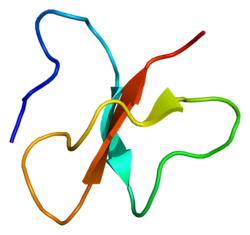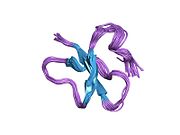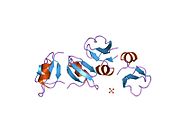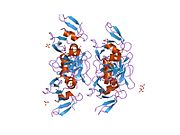- Beta-defensin 2
-
Defensin, beta 4A 
PDB rendering based on 1e4q.Available structures PDB 1E4Q, 1FD3, 1FD4, 1FQQ Identifiers Symbols DEFB4A; BD-2; DEFB-2; DEFB102; DEFB2; DEFB4; HBD-2; SAP1 External IDs OMIM: 602215 HomoloGene: 122147 GeneCards: DEFB4A Gene Gene Ontology Cellular component • extracellular region Biological process • chemotaxis
• immune response
• G-protein coupled receptor protein signaling pathway
• defense response to bacteriumSources: Amigo / QuickGO Orthologs Species Human Mouse Entrez 1673 n/a Ensembl ENSG00000171711 n/a UniProt O15263 n/a RefSeq (mRNA) NM_004942 n/a RefSeq (protein) NP_004933 n/a Location (UCSC) Chr 8:
7.75 – 7.75 Mbn/a PubMed search [1] n/a Beta-defensin 2 (BD-2) also known as skin-antimicrobial peptide 1 (SAP1) is a peptide that in humans is encoded by the DEFB4 (defensin, beta 4) gene.[1]
Human beta-defensin-2 (hBD-2) is a cysteine-rich cationic low molecular weight antimicrobial peptide recently discovered in lesional skin.
Contents
Structure
hBD-2 is a protein whose primary structure is made by 64 aminoacids. At concentrations ≤2.4 mM, hBD-2 is monomeric.[2] The structure is amphiphilic with a nonuniform surface distribution of positive charge and contains several key structural elements, including a triple-stranded, antiparallel beta sheet with strands 2 and 3 in a beta hairpin conformation. The determination of other structural elements depends on the technique used. When X-ray crystallography is used an alpha helix can be observed at the C-terminal end of the protein (PDB code: 1fd3). When using NMR this alpha-helix does not appear (PDB code: 1e4q).
Function
Defensins form a family of microbicidal and cytotoxic peptides made by neutrophils. Members of the defensin family are highly similar in protein sequence. Beta-defensin 2 is an antibiotic peptide which is locally regulated by inflammation.[3]
Human beta-defensin 2 is produced by a number of epithelial cells and exhibits potent antimicrobial activity against Gram-negative bacteria and Candida, but not Gram-positive S. aureus. It has been speculated that beta-defensin 2 may contribute to the infrequency of Gram-negative infections on skin and lung tissue.[4]
hBD-2 represents the first human defensin that is produced following stimulation of epithelial cells by contact with microorganisms such as P. aeruginosa or cytokines such as TNF-alpha and IL-1 beta. The HBD-2 gene and protein are locally expressed in keratinocytes associated with inflammatory skin lesions. It is intriguing to speculate that HBD-2 is a dynamic component of the local epithelial defense system of the skin and respiratory tract having a role to protect surfaces from infection, and providing a possible reason why skin and lung infections with Gram-negative bacteria are rather rare.[4]
Although this protein doesn’t have any antibacterial activity against Gram-positive bacteria, there is a study showing that there is a synergy between hBD-2 and other proteins.[5] One example of this synergistic effect is with epiP, a protein segregated by some strains of S. epidermidis. hBD2, holding hands with epiP, is capable of killing S. aureus, a Gram-positive bacteria responsible of human diseases.
References
- ^ Harder J, Bartels J, Christophers E, Schroder JM (Jul 1997). "A peptide antibiotic from human skin". Nature 387 (6636): 861. doi:10.1038/43088. PMID 9202117.
- ^ Sawai MV, Jia HP, Liu L, Aseyev V, Wiencek JM, McCray PB Jr, Ganz T, Kearney WR, Tack BF.(2001) (2001). ")" The NMR structure of human beta-defensin-2 reveals a novel alpha-helical segment."". Biochemistry 40 (13): 3810–3816. doi:10.1021/bi002519d. PMID 11300761.
- ^ "Entrez Gene: DEFB4 defensin, beta 4". http://www.ncbi.nlm.nih.gov/sites/entrez?Db=gene&Cmd=ShowDetailView&TermToSearch=1673.
- ^ a b Schröder JM, Harder J (June 1999). "Human beta-defensin-2". Int. J. Biochem. Cell Biol. 31 (6): 645–51. doi:10.1016/S1357-2725(99)00013-8. PMID 10404637.
- ^ Tadayuki Iwase, Yoshio Uehara, Hitomi Shinji, Akiko Tajima, Hiromi Seo, Koji Takada, Toshihiko Agata Yoshimitsu Mizunoe (2010) (2010). ""Staphylococcus epidermidis Esp inhibits Staphylococcus aureus biofilm formation and nasal colonization".". Nature. 465 (7296): 346–349. doi:10.1038/nature09074. PMID 20485435.
Further reading
- Weinberg A, Krisanaprakornkit S, Dale BA (1999). "Epithelial antimicrobial peptides: review and significance for oral applications.". Crit. Rev. Oral Biol. Med. 9 (4): 399–414. doi:10.1177/10454411980090040201. PMID 9825219.
- Schröder JM, Harder J (1999). "Human beta-defensin-2.". Int. J. Biochem. Cell Biol. 31 (6): 645–51. doi:10.1016/S1357-2725(99)00013-8. PMID 10404637.
- Bals R, Wang X, Wu Z, et al. (1998). "Human beta-defensin 2 is a salt-sensitive peptide antibiotic expressed in human lung.". J. Clin. Invest. 102 (5): 874–80. doi:10.1172/JCI2410. PMID 9727055.
- Liu L, Wang L, Jia HP, et al. (1999). "Structure and mapping of the human beta-defensin HBD-2 gene and its expression at sites of inflammation.". Gene 222 (2): 237–44. doi:10.1016/S0378-1119(98)00480-6. PMID 9831658.
- Mathews M, Jia HP, Guthmiller JM, et al. (1999). "Production of beta-defensin antimicrobial peptides by the oral mucosa and salivary glands.". Infect. Immun. 67 (6): 2740–5. PMC 96577. PMID 10338476. http://www.pubmedcentral.nih.gov/articlerender.fcgi?tool=pmcentrez&artid=96577.
- Jia HP, Mills JN, Barahmand-Pour F, et al. (1999). "Molecular cloning and characterization of rat genes encoding homologues of human beta-defensins.". Infect. Immun. 67 (9): 4827–33. PMID 10456937.
- Yang D, Chertov O, Bykovskaia SN, et al. (1999). "Beta-defensins: linking innate and adaptive immunity through dendritic and T cell CCR6.". Science 286 (5439): 525–8. doi:10.1126/science.286.5439.525. PMID 10521347.
- Diamond G, Kaiser V, Rhodes J, et al. (2000). "Transcriptional regulation of beta-defensin gene expression in tracheal epithelial cells.". Infect. Immun. 68 (1): 113–9. PMID 10603376.
- Harder J, Meyer-Hoffert U, Teran LM, et al. (2000). "Mucoid Pseudomonas aeruginosa, TNF-alpha, and IL-1beta, but not IL-6, induce human beta-defensin-2 in respiratory epithelia.". Am. J. Respir. Cell Mol. Biol. 22 (6): 714–21. PMID 10837369.
- Hoover DM, Rajashankar KR, Blumenthal R, et al. (2000). "The structure of human beta-defensin-2 shows evidence of higher order oligomerization.". J. Biol. Chem. 275 (42): 32911–8. doi:10.1074/jbc.M006098200. PMID 10906336.
- Meyer JE, Harder J, Görögh T, et al. (2000). "[hBD-2 gene expression in nasal mucosa]". Laryngorhinootologie 79 (7): 400–3. PMID 11005092.
- Ali RS, Falconer A, Ikram M, et al. (2001). "Expression of the peptide antibiotics human beta defensin-1 and human beta defensin-2 in normal human skin.". J. Invest. Dermatol. 117 (1): 106–11. doi:10.1046/j.0022-202x.2001.01401.x. PMID 11442756.
- Carothers DG, Graham SM, Jia HP, et al. (2001). "Production of beta-defensin antimicrobial peptides by maxillary sinus mucosa.". American journal of rhinology 15 (3): 175–9. doi:10.2500/105065801779954238. PMID 11453504.
- Biragyn A, Surenhu M, Yang D, et al. (2002). "Mediators of innate immunity that target immature, but not mature, dendritic cells induce antitumor immunity when genetically fused with nonimmunogenic tumor antigens.". J. Immunol. 167 (11): 6644–53. PMID 11714836.
- Bauer F, Schweimer K, Klüver E, et al. (2002). "Structure determination of human and murine beta-defensins reveals structural conservation in the absence of significant sequence similarity.". Protein Sci. 10 (12): 2470–9. doi:10.1110/ps.24401. PMC 2374044. PMID 11714914. http://www.pubmedcentral.nih.gov/articlerender.fcgi?tool=pmcentrez&artid=2374044.
- Takahashi A, Wada A, Ogushi K, et al. (2001). "Production of beta-defensin-2 by human colonic epithelial cells induced by Salmonella enteritidis flagella filament structural protein.". FEBS Lett. 508 (3): 484–8. doi:10.1016/S0014-5793(01)03088-5. PMID 11728477.
- Schibli DJ, Hunter HN, Aseyev V, et al. (2002). "The solution structures of the human beta-defensins lead to a better understanding of the potent bactericidal activity of HBD3 against Staphylococcus aureus.". J. Biol. Chem. 277 (10): 8279–89. doi:10.1074/jbc.M108830200. PMID 11741980.
PDB gallery 
This protein-related article is a stub. You can help Wikipedia by expanding it.




